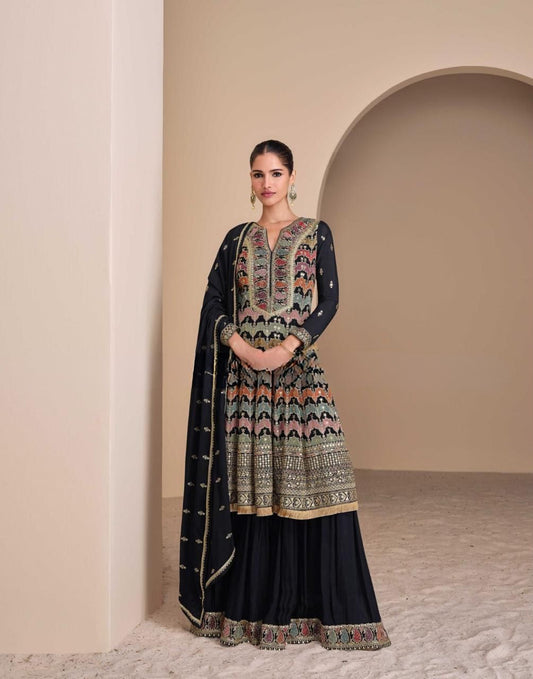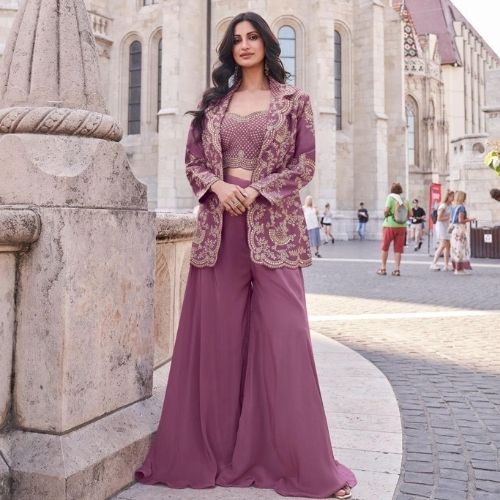Silk Sarees:
- Patan Patola (Gujarat) – Double Ikat masterpiece in silk.
- Baluchari Silk (West Bengal) – Storytelling sarees with mythological scenes.
- Mysore Silk (Karnataka) – Smooth and lustrous with minimalistic zari work.
- Dharmavaram Silk (Andhra Pradesh) – Known for broad borders and vibrant colors.
- Bhagalpuri Silk (Bihar) – Raw tussar silk with earthy tones.
Cotton Sarees:
- Chettinad Cotton (Tamil Nadu) – Traditional checked cotton sarees.
- Venkatagiri Cotton (Andhra Pradesh) – Lightweight with silver zari designs.
- Kota Doria (Rajasthan) – Woven checkered cotton sarees.
- Jamdani (West Bengal) – Muslin cotton with handwoven patterns.
- Narayanpet Cotton (Telangana) – Striped or checked patterns with zari borders.
Handloom and Woven Sarees:
- Ikat Sarees (Odisha/Telangana) – Intricate resist-dyeing technique.
- Tangail Sarees (West Bengal) – Fine cotton with floral or paisley motifs.
- Kullu Woolen Sarees (Himachal Pradesh) – Traditional woven sarees for winters.
- Coimbatore Sarees (Tamil Nadu) – A blend of silk and cotton with a glossy finish.
- Sico Sarees (Tamil Nadu) – A mix of silk and cotton with vibrant colors.
Embroidered Sarees:
- Lucknow Chikankari Saree (Uttar Pradesh) – Elegant hand embroidery on fine fabrics.
- Kantha Stitch Saree (West Bengal) – Running stitch embroidery with motifs.
- Gota Work Saree (Rajasthan) – Zari appliqué with golden and silver threads.
- Phulkari Saree (Punjab) – Vibrant floral thread embroidery.
- Mirror Work Saree (Gujarat/Rajasthan) – Embellished with tiny reflective mirrors.
Printed Sarees:
- Ajrakh Saree (Gujarat) – Block-printed with natural dyes.
- Bagh Print Saree (Madhya Pradesh) – Hand-block printed floral and geometric patterns.
- Kalamkari Saree (Andhra Pradesh) – Hand-painted mythological themes.
- Dabu Print Saree (Rajasthan) – Mud-resist block printing.
- Shibori Saree (Japan-inspired, Rajasthan/India) – Tie-dye with unique patterns.
Festival and Bridal Sarees:
- Banarasi Saree (Uttar Pradesh) – Heavy zari and brocade designs.
- Paithani Saree (Maharashtra) – Peacock motifs and golden zari.
- Kanjeevaram Saree (Tamil Nadu) – Rich silk with contrasting broad borders.
- Assam Muga Silk Saree (Assam) – Lustrous natural gold sheen silk.
- Chanderi Saree (Madhya Pradesh) – Sheer, lightweight sarees with zari borders.
Contemporary Sarees:
- Georgette Saree – Flowing, lightweight sarees ideal for casual and festive occasions.
- Organza Saree – Sheer fabric with subtle embroidery.
- Net Saree – Transparent and glamorous, often with heavy embellishments.
- Chiffon Saree – Lightweight, soft fabric for modern looks.
- Satin Saree – Glossy and smooth, ideal for parties.
Tribal and Regional Sarees:
- Meghalaya Ryndia Saree – Made from Eri silk with eco-friendly techniques.
- Naga Saree (Nagaland) – Bold patterns and handwoven textures.
- Bodo Dokhona Saree (Assam) – Traditional tribal drapes.
- Manipuri Moirang Phee Saree (Manipur) – Traditional handloom with temple motifs.
- Toda Saree (Tamil Nadu) – Embroidered tribal saree with geometric patterns.
Tie-Dye and Hand-Dyed Sarees:
- Bandhani Saree (Gujarat/Rajasthan) – Tie-dyed with colorful patterns.
- Leheriya Saree (Rajasthan) – Wavy tie-dye designs.
- Pochampally Ikat Saree (Telangana) – Unique geometric patterns using Ikat dyeing.
- Bomkai Saree (Odisha) – Fusion of tribal and intricate handloom designs.
Eco-Friendly and Sustainable Sarees:
- Eri Silk Saree (Assam) – Also known as "peace silk," soft and durable.
- Ahimsa Silk Saree – Silk harvested without harming silkworms.
- Khadi Cotton Saree – Hand-spun and handwoven cotton sarees.
- Linen Saree – Breathable, eco-friendly fabric ideal for summers.
Unique Weaves and Motifs:
- Konrad Saree (Tamil Nadu) – Known as temple sarees with wide borders.
- Ilkal Saree (Karnataka) – Unique pallu woven separately and attached.
- Venkatagiri Saree (Andhra Pradesh) – Delicate silver zari with floral designs.
- Dhakai Saree (Bangladesh) – Fine muslin with intricate thread work.
- Uppada Saree (Andhra Pradesh) – Lightweight silk sarees with zari patterns.












